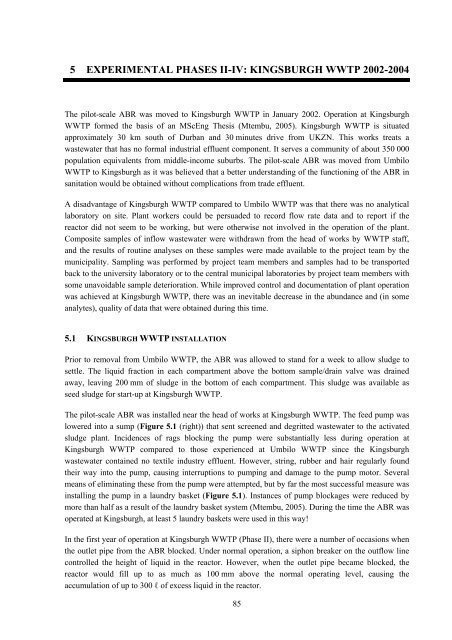analysis of a pilot-scale anaerobic baffled reactor treating domestic ...
analysis of a pilot-scale anaerobic baffled reactor treating domestic ...
analysis of a pilot-scale anaerobic baffled reactor treating domestic ...
You also want an ePaper? Increase the reach of your titles
YUMPU automatically turns print PDFs into web optimized ePapers that Google loves.
5 EXPERIMENTAL PHASES II-IV: KINGSBURGH WWTP 2002-2004<br />
The <strong>pilot</strong>-<strong>scale</strong> ABR was moved to Kingsburgh WWTP in January 2002. Operation at Kingsburgh<br />
WWTP formed the basis <strong>of</strong> an MScEng Thesis (Mtembu, 2005). Kingsburgh WWTP is situated<br />
approximately 30 km south <strong>of</strong> Durban and 30 minutes drive from UKZN. This works treats a<br />
wastewater that has no formal industrial effluent component. It serves a community <strong>of</strong> about 350 000<br />
population equivalents from middle-income suburbs. The <strong>pilot</strong>-<strong>scale</strong> ABR was moved from Umbilo<br />
WWTP to Kingsburgh as it was believed that a better understanding <strong>of</strong> the functioning <strong>of</strong> the ABR in<br />
sanitation would be obtained without complications from trade effluent.<br />
A disadvantage <strong>of</strong> Kingsburgh WWTP compared to Umbilo WWTP was that there was no analytical<br />
laboratory on site. Plant workers could be persuaded to record flow rate data and to report if the<br />
<strong>reactor</strong> did not seem to be working, but were otherwise not involved in the operation <strong>of</strong> the plant.<br />
Composite samples <strong>of</strong> inflow wastewater were withdrawn from the head <strong>of</strong> works by WWTP staff,<br />
and the results <strong>of</strong> routine analyses on these samples were made available to the project team by the<br />
municipality. Sampling was performed by project team members and samples had to be transported<br />
back to the university laboratory or to the central municipal laboratories by project team members with<br />
some unavoidable sample deterioration. While improved control and documentation <strong>of</strong> plant operation<br />
was achieved at Kingsburgh WWTP, there was an inevitable decrease in the abundance and (in some<br />
analytes), quality <strong>of</strong> data that were obtained during this time.<br />
5.1 KINGSBURGH WWTP INSTALLATION<br />
Prior to removal from Umbilo WWTP, the ABR was allowed to stand for a week to allow sludge to<br />
settle. The liquid fraction in each compartment above the bottom sample/drain valve was drained<br />
away, leaving 200 mm <strong>of</strong> sludge in the bottom <strong>of</strong> each compartment. This sludge was available as<br />
seed sludge for start-up at Kingsburgh WWTP.<br />
The <strong>pilot</strong>-<strong>scale</strong> ABR was installed near the head <strong>of</strong> works at Kingsburgh WWTP. The feed pump was<br />
lowered into a sump (Figure 5.1 (right)) that sent screened and degritted wastewater to the activated<br />
sludge plant. Incidences <strong>of</strong> rags blocking the pump were substantially less during operation at<br />
Kingsburgh WWTP compared to those experienced at Umbilo WWTP since the Kingsburgh<br />
wastewater contained no textile industry effluent. However, string, rubber and hair regularly found<br />
their way into the pump, causing interruptions to pumping and damage to the pump motor. Several<br />
means <strong>of</strong> eliminating these from the pump were attempted, but by far the most successful measure was<br />
installing the pump in a laundry basket (Figure 5.1). Instances <strong>of</strong> pump blockages were reduced by<br />
more than half as a result <strong>of</strong> the laundry basket system (Mtembu, 2005). During the time the ABR was<br />
operated at Kingsburgh, at least 5 laundry baskets were used in this way!<br />
In the first year <strong>of</strong> operation at Kingsburgh WWTP (Phase II), there were a number <strong>of</strong> occasions when<br />
the outlet pipe from the ABR blocked. Under normal operation, a siphon breaker on the outflow line<br />
controlled the height <strong>of</strong> liquid in the <strong>reactor</strong>. However, when the outlet pipe became blocked, the<br />
<strong>reactor</strong> would fill up to as much as 100 mm above the normal operating level, causing the<br />
accumulation <strong>of</strong> up to 300 ℓ <strong>of</strong> excess liquid in the <strong>reactor</strong>.<br />
85
















